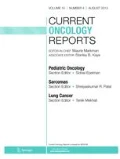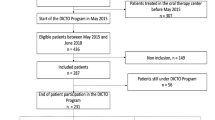Abstract
Currently, 10% of cancer chemotherapy is prescribed to patients by means of an oral formulation, but, by 2013, this percentage is predicted to increase to 25%. Oral chemotherapy offers many advantages, including no need for sometimes painful intravenous access, no intravenous drug administration fees, more time at home for patients, and a greater sense of patient autonomy. However, oral cancer chemotherapy also poses challenges, many of which revolve around adherence and safety. These challenges are discussed here. There are few other circumstances in which patient education and the maintenance of institutional safety infrastructure play such an integral role in sustaining favorable cancer clinical outcomes.
Similar content being viewed by others
References
Papers of particular interest, published recently, have been highlighted as: • Of importance
http://www.jamesgeary.com/blog/aphorisms-by-zoran-t-popovic/ Accessed April 15, 2010.
Weingart SN, Brown E, Bach PB, et al.: NCCN task force report: oral chemotherapy. J Natl Compr Canc Netw 2008, Suppl 3:S1–S14.
Winkeljohn DL: Oral chemotherapy medications: the need for the nurse’s touch. Clin J Oncol Nurs 2007, 11:793–796.
Gornas M, Szczylik C: Oral treatment of metastatic breast cancer with capecitabine: what influences the decision making process? Eur J Cancer Care (Engl) 2010, 19:131–136.
Liu G, Franssen E, Fitch MI, Warner E: Patient preferences for oral versus intravenous palliative chemotherapy. J Clin Oncol 1997, 15:110–115.
Twelves C, Wong A, Nowacki MP, et al.: Capecitabine as adjuvant treatment for stage III colon cancer. N Engl J Med 2005, 352:2696–2704.
O’Bryant CL, Crandell BC: Community pharmacists’ knowledge of and attitudes toward oral chemotherapy. J Am Pharm Assoc 2008, 48:632–639.
Shah HR, Ledbetter L, Diasio R, Saif MW: A retrospective study of coagulation abnormalities in patients receiving concomitant capecitabine and warfarin. Clin Colorectal Cancer 2006, 5:354–358.
Catania C, Didier F, Leon ME, et al.: Perception that oral anticancer treatments are less efficacious: development of a questionnaire to assess the possible prejudices of patients with cancer. Breast Cancer Res Treat 2005, 92:265–272.
Eckardt JR, von Pawel J, Pujol JL, et al.: Phase III study of oral compared with intravenous topotecan as second-line therapy in small cell lung cancer. J Clin Oncol 2007, 25:2086–2092.
Boogaerts MA, Van Hoof A, Catovsky D, et al.: Activity of oral fludarabine phosphate in previously treated chronic lymphocytic leukemia. J Clin Oncol 2001, 19:4252–4258.
• Mok TS, Wu YL, Thongprasert S, et al.: Gefitinib or carboplatin-paclitaxel in pulmonary adenocarcinoma. N Engl J Med 2009, 361:947–957. This article represents a robust, comparative study that shows an oral cancer agent demonstrated superior outcomes in a select group of cancer patients.
Pavlovsky C, Kantarjian H, Cortes JE: First-line therapy for chronic myeloid leukemia: past, present, and future. Am J Hematol 2009, 84:287–293.
Decker V, Spoelstra S, Miezo E, et al.: A pilot study of an automated voice response system and nursing intervention to monitor adherent to oral chemotherapy agents. Cancer Nurs 2009, 32:E20–E29.
Grunfeld EA, Hunter MS, Sikka P, Mittal S: Adherence beliefs among breast cancer patients taking tamoxifen. Patient Educ Couns 2005, 59:97–102.
Ziller V, KAlder M, Albert US, et al.: Adherence to adjuvant endocrine therapy in postmenopausal women with breast cancer. Ann Oncol 2009, 20:431–436.
• McCowan C, Shearer J, Donnan PT, et al.: Cohort study examining tamoxifen adherence and its relationship to mortality in women with breast cancer. Br J Cancer 2008, 99:1763–1768. This study shows that medication adherence is associated with important clinical outcomes—in this instance, survival outcomes.
Machado M, Bajcar J, Guzzo GC, Einarson TR: Sensitivity of patient outcomes to pharmacist interventions. Ann Pharmacother 2007, 41:1770–1781.
Reigner B, Verweij J, Dirix L, et al.: Effect of food on the pharmacokinetics of capecitabine and its metabolites following oral administration in cancer patients. Clin Cancer Res 1998, 4:941–948.
• Koch KM, Reddy NJ, Cohen RB, et al.: Effects of food on the relative bioavailability of lapatinib in cancer patients. J Clin Oncol 2009, 27:1191–1196. The food effects observed in this study are great, thus emphasizing the importance of educating all patients on how best to take oral chemotherapy with respect to food intake.
Buzdar AU, Hortobagyi GN, FRye D, et al.: Bioequivalence of 20 mg once-daily tamoxifen relative to 10-mg twice-daily tamoxifen regimens for breast cancer. J Clin Oncol 1994, 12:50–54.
• Jacobson JO, Polovich M, McNiff KK, et al.: American Society of Clinical Oncology/Oncology Nursing Society chemotherapy administration safety standards. J Clin Oncol 2009, 27:5469–5475. At present, this article constitutes the reference for safe chemotherapy prescribing practices.
Weingart SN: Oral chemotherapy safety practices at US cancer centers: questionnaire survey. BMJ 2007, 334:407.
Acknowledgment
This work was partially funded by K24CA131099.
Disclosure
No potential conflicts of interest relevant to this article were reported.
Author information
Authors and Affiliations
Corresponding author
Rights and permissions
About this article
Cite this article
Halfdanarson, T.R., Jatoi, A. Oral Cancer Chemotherapy: The Critical Interplay Between Patient Education and Patient Safety. Curr Oncol Rep 12, 247–252 (2010). https://doi.org/10.1007/s11912-010-0103-6
Published:
Issue Date:
DOI: https://doi.org/10.1007/s11912-010-0103-6




